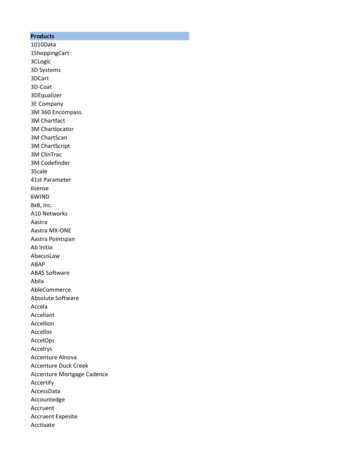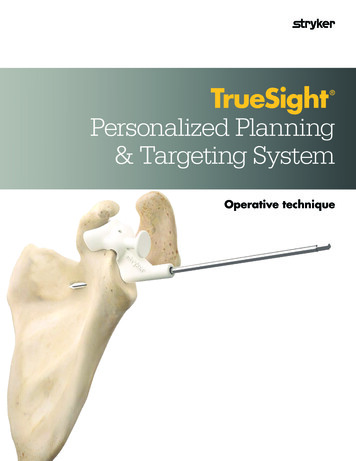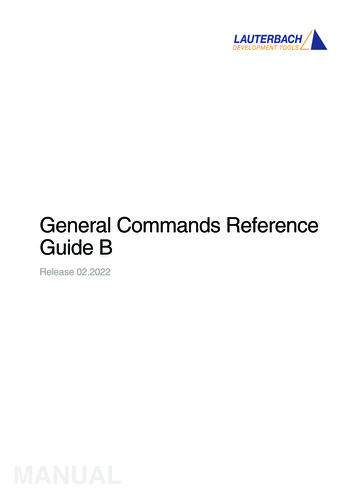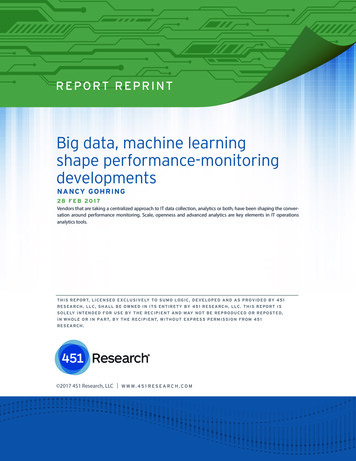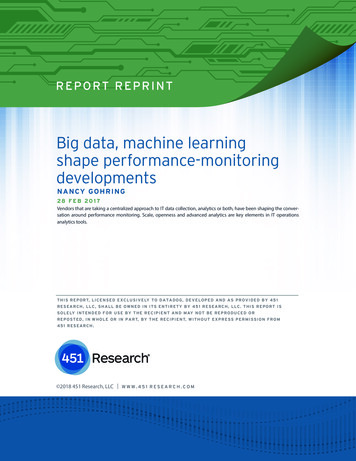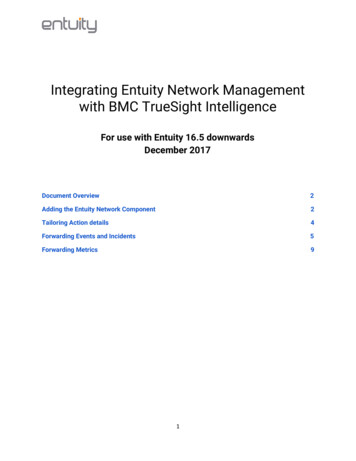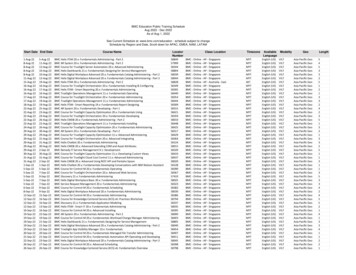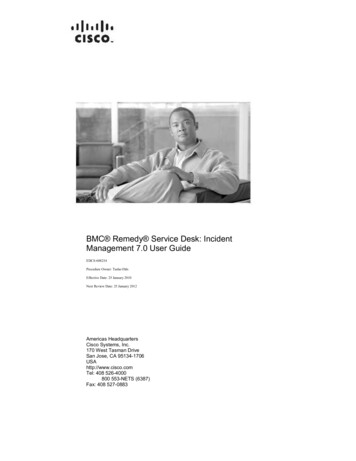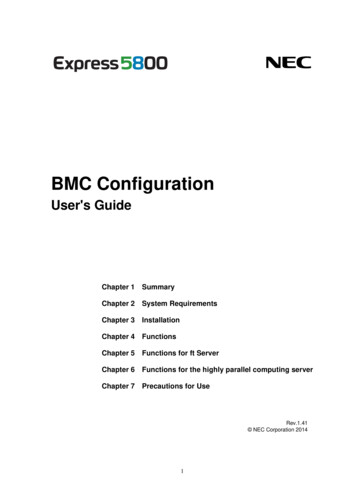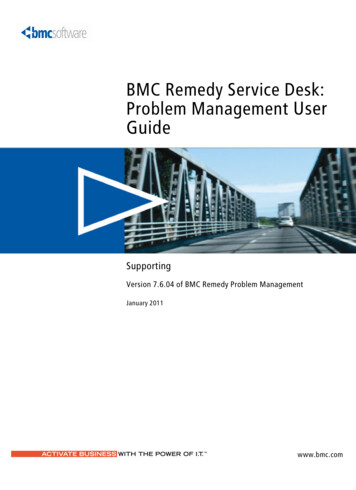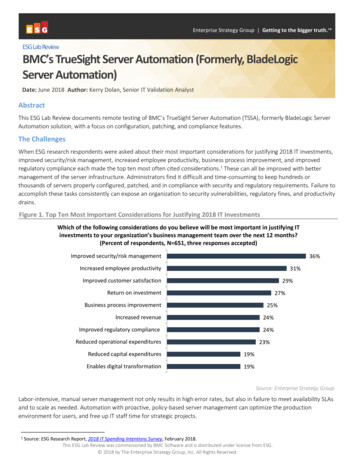
Transcription
Enterprise Strategy Group Getting to the bigger truth. ESG Lab ReviewBMC’s TrueSight Server Automation (Formerly, BladeLogicServer Automation)Date: June 2018 Author: Kerry Dolan, Senior IT Validation AnalystAbstractThis ESG Lab Review documents remote testing of BMC’s TrueSight Server Automation (TSSA), formerly BladeLogic ServerAutomation solution, with a focus on configuration, patching, and compliance features.The ChallengesWhen ESG research respondents were asked about their most important considerations for justifying 2018 IT investments,improved security/risk management, increased employee productivity, business process improvement, and improvedregulatory compliance each made the top ten most often cited considerations.1 These can all be improved with bettermanagement of the server infrastructure. Administrators find it difficult and time-consuming to keep hundreds orthousands of servers properly configured, patched, and in compliance with security and regulatory requirements. Failure toaccomplish these tasks consistently can expose an organization to security vulnerabilities, regulatory fines, and productivitydrains.Figure 1. Top Ten Most Important Considerations for Justifying 2018 IT InvestmentsWhich of the following considerations do you believe will be most important in justifying ITinvestments to your organization’s business management team over the next 12 months?(Percent of respondents, N 651, three responses accepted)Improved security/risk management36%Increased employee productivity31%Improved customer satisfaction29%Return on investment27%Business process improvement25%Increased revenue24%Improved regulatory compliance24%Reduced operational expenditures23%Reduced capital expenditures19%Enables digital transformation19%Source: Enterprise Strategy GroupLabor-intensive, manual server management not only results in high error rates, but also in failure to meet availability SLAsand to scale as needed. Automation with proactive, policy-based server management can optimize the productionenvironment for users, and free up IT staff time for strategic projects.1Source: ESG Research Report, 2018 IT Spending Intentions Survey, February 2018.This ESG Lab Review was commissioned by BMC Software and is distributed under license from ESG. 2018 by The Enterprise Strategy Group, Inc. All Rights Reserved.
Lab Review: BMC TrueSight Server Automation2The Solution: TrueSight Server AutomationTSSA is part of the BMC data center automation suite that also includes network and process automation. Organizations useTSSA to manage physical, virtual, and cloud servers across Windows, Linux, and UNIX operating systems through a singlepane of glass. TSSA also enables precise changes to be executed with fine-grained, role-based access that keeps systemssecure and stable.At a high level, TSSA helps IT to not just manage servers and understand their status, but also actively remediateproblems—without requiring scripting. Organizations can discover servers, audit their configurations, make changes toconfigurations, and deploy software quickly and easily. If a change to an individual system or group doesn’t work asexpected, administrastors can quickly roll it back, saving time and reducing risk. This comprehensive ability to identifyproblems and fix them is a key aspect of the solution. TSSA enables administrators to employ a policy-based, consistent,reliable server management regimen with less administrative effort and cost. TSSA features simplify: Compliance. Discover, monitor, remediate, and integrate change control to remain compliant and audit-ready.Preconfigured regulatory policies include CIS, DISA, HIPAA, PCI-DSS, SOX, and more. Patching. Control server lifecycles with regular patching to optimize new features and maintain security, while reducing downtime.Configuration. Automatically maintain configurations to organizational standards with granular control.Provisioning. Receive OS-aware packaging, unattended installs, and provisioning through image-, script-, or templatebased approaches.Reporting. View real-time and historical details and dashboards for compliance, inventory, provisioning, patching, anddeployment.Task-automation. Incorporate customized tasks such as network shell commands, preexisting scripts, or configurationchanges to automate end-to-end tasks.TSSA is integrated with IT service management and governance processes, including other BMC solutions such as TrueSightVulnerability Management and Remedy.Figure 2. BladeLogic Server AutomationSource: Enterprise Strategy Group 2018 by The Enterprise Strategy Group, Inc. All Rights Reserved.
Lab Review: BMC TrueSight Server Automation3ESG Lab TestingESG Lab performed remote testing of TSSA on a test bed in Phoenix, AZ, leveraging TSSA version 8.9 on a Windows 2012 R2Standard server with 16 GB of RAM. The test bed included Windows 2008 and 2012, Red Hat and SUSE Linux, Ubuntu,Debian, and Oracle Solaris servers. Testing focused on configuration, compliance, and patching capabilities. For thisvalidation, ESG used the client user interface that is targeted toward expert users. TSSA has a separate web portal-basedinterface for operators or infrequent users that is easier to use, but less functional than the client user interface. It shouldbe noted that this testing covered only a subset of the extensive capabilities that TSSA offers.ConfigurationESG Lab started by examining the Live Browse feature. For any server, we could view details including hardware, memory,compute resources, boot history, domain role, etc. TSSA uses a powerful but lightweight agent to communicate with eachapplication server.Because it uses aproprietary, encrypted“speak when spokento” protocol, it doesn'trequire SSH or othertransport; this enablesit to make serverconnections quicklyand scale easily. Foreach server, we could view installed objects and services, drill down to individual items, and take actions such as startingservices, snapshots, and audits. The screenshot above shows the objects available for the Windows application blapp.TSSA makes it easy to capture even a single configuration from an endpoint and package it for deployment or remediation.After drilling down on Services for blapp, ESG Lab selected VMware Tools, right-clicked, and selected Add to Depot as BLPackage. TSSA then created the software package and saved it. This process is vastly simpler than building a service from CLIor trying to script it. In addition, this fine-grained abilityto track a single service, rather than the entire servicestable with multiple objects, makes the process faster,easier, and more reliable. It is equally simple and fast toright-click on Audit to compare with other systems in theenvironment, or Snapshot to do change tracking or topreserve the system state. In addition, TSSA understandsthe different formats that operating systems use, so itcan parse configurations and capture them without error,enabling administrators to change a single configurationacross the entire environment. Software can also beuninstalled with a simple right-click.A key attribute is that TSSA tasks have the same look and feel across different platforms. Figure 3 shows four servers withfour different operating systems in the same TSSA GUI: a Windows server with Applications open; an Oracle Database 11 onSolaris with Packages open; an Ubuntu server with Debian Packages open; and a Red Hat Linux server with RPMs open. Thisenables the administrator to manage all the systems across the environment with the same tool, at the same time, with thesame look and feel. 2018 by The Enterprise Strategy Group, Inc. All Rights Reserved.
Lab Review: BMC TrueSight Server Automation4Figure 3. Consistent Cross-platform Look and FeelSource: Enterprise Strategy GroupCreating a Snapshot for File Integrity TrackingESG Lab executed configuration tasks, starting with a snapshot of the environment to use for file integrity change tracking.The simple steps enable administrators to choose the number of servers to snap, and to select specific server objects andconfigurations, with notifications and scheduling. We could select specific servers or smart groups tailored to companyneeds, such as particular compliance status, application tier, location, department, etc. ESG Lab configured the snapshot tocapture the C:/temp folder, C/Windows/system32/drivers/etc/hosts configuration file, and VMware tools Windows servicefor the blapp server. Once we had clicked Finish, we watched as TSSA captured information.Next, to simulate changes that can occur in the real world, we added two files to the BBSA89-RSCDAgents subfolder in theC:/temp folder for blapp: autorun.inf represented an authorized change, and badhacker.dll represented an unauthorizedchange. ESG Lab next viewed the process of auditing the environment for changes by rerunning the snapshot job on blapp.An advantage of TSSA is that this snapshot only collects changed data, making it fast and low-cost. If there are no changes,or only a megabyte here and there, that’s all TSSA collects. Other solutions take a full snapshot of the environment, takingup storage space, time, and cost.In this snapshot, the temp folder in the Snapshot window was displayed in bold, red text to indicate changes, including thedate of modification; the folders that had no changes were not displayed in that screen. Drilling down in the changed folder,we noted the two files that had been added. Change tracking can also be scheduled and reconciled against authorizedchanges using change management systems such as BMC Remedy. 2018 by The Enterprise Strategy Group, Inc. All Rights Reserved.
Lab Review: BMC TrueSight Server Automation5We could roll back all the changes in an automated fashion. In this case, TSSA automatically creates and launches a BLDeploy job. However, part of TSSA’s power is the ability to roll back only a single change, which we did by right-clicking onbadhacker.dll and selecting Package Snapshot Delta. With a few clicks—and no scripts—we configured TSSA to create apackage to roll back that change.To deploy it, we created a BL Deploy job. This includes sending a change management approval request if needed, andconfiguring the target server, notifications, and scheduling. Options include: Administrators can schedule tasks to be simulated, staged, and committed at different times. For example, they cansimulate a task at 3 pm to be sure the right permissions and storage are in place, then schedule it to be staged at 8 pmand finally committed at 11 pm at the beginning of the maintenance window. This way, the task begins immediately,rather than having the administrator simulate and stage it, taking up part of the maintenance window. Jobs can be configured to pause when the maintenance window ends and start up again with the next window. Thisprevents the job from continuing into production time and requiring a disruptive reboot. TSSA enables administrators to automatically create a change control ticket or tie into an existing ticket, savingvaluable administrative time. Administrators can use either native software packaging technologies for each operating system or TSSA packaging(such as BL deploy) that lets them intelligently interact with multiple operating systems without the complication ofdifferent packaging technologies.Once this task was completed, badhacker.dll was no longer configured in the C:/temp folder. We also looked at a similartask using the Audit job, which many organizations use to keep servers configured to a defined standard, such as to a“golden image.” With this task, the changes (such as extra or missing files) are listed in a separate window, making it easyfor administrators of large server farms to identify non-compliant servers and bring them into compliance.Why This MattersKeeping hundreds or thousands of servers optimally configured is a daunting task that takes up significant ITadministrator time—and administrators are expensive. Manual server management and scripting are also error-prone.Multiple platforms—Windows, several flavors of Linux, and legacy systems like AIX, all with numerous versions tosupport—complicate management even further, especially with multiple, separately managed point tools that providedifferent capabilities.ESG Lab validated that TSSA provides a single server management tool with configuration automation that supportsnumerous platforms with the same look and feel, simplifying tasks and saving time and money. With TSSA, junior staffcan manage servers, freeing up high level administrators for more strategic projects. Organizations eliminate concernsabout server tools working together, and users can leverage the applications they want without complicating servermanagement. TSSA enables policy-based management and ongoing validation so that servers maintain the rightcapabilities and avoid conflicting changes and chaos. 2018 by The Enterprise Strategy Group, Inc. All Rights Reserved.
Lab Review: BMC TrueSight Server Automation6Patching and CompliancePatching and compliance tasks are essential for optimizing functionality, reducing risk, and maintaining security levels. TSSAautomation can accomplish these goals while gaining back productive time.PatchingKeeping servers up to date with OS patches across platforms is a tedious, time-consuming task, and TSSA automates thatprocess. The top left side of Figure 4 shows patch catalogs for AIX, Red Hat Linux, Solaris, Ubuntu, SuSE Linux, and Windowsall in one screen. Catalog updates can be scheduled to run on a regular basis. From the Windows patch catalog, ESG Labright-clicked and selected Analyze using this catalog to get the patch status of a set of Windows servers in the environment.The analysis showed which servers were missing which patches, including bulletins and hotfixes, and their severity rating.The top right of Figure 4 shows failed and successful targets; in this case, three of the servers were unavailable, hence thered Xs. From the Successful Targets list, ESG Lab selected the blwinwww server, and had options to remediate all servers ordownload missing patches. We drilled down on that server to show installed and missing patches (Figure 4, bottom). Afterselecting one of the critical patches, we right-clicked and selected Deploy Selected Patches. We had options to completethem now or to simulate, stage, and commit them later. With the flexibility to remediate all servers and patches, or toselect specific servers and/or patches, organizations have the power to optimize the server environment to suit their needs.Figure 4. Patching and RemediationSource: Enterprise Strategy Group 2018 by The Enterprise Strategy Group, Inc. All Rights Reserved.
Lab Review: BMC TrueSight Server Automation7To detect vulnerabilities, many organizations use vulnerability scanners from vendors such as Qualys, Tenable, and Rapid7.These tools produce large reports that must be parsed, analyzed, and compared to available remediations. BMC has asolution called TrueSight Vulnerability Management (TVSM) that can import these vulnerability scans, automatically mapvulnerabilities to known remediations, assign severity, and help operators prioritize remediation actions. TSVM works withpatching solutions including TSSA to execute remediation actions such as patching or configuration changes. TSVM was notpart of this ESG Lab validation.ComplianceTSSA also provides out-of-the-box compliance templates for numerous regulations across industries, including SOX, DISA,HIPAA, PCI-DSS, CIS, and more. These regulations may be mandatory depending on the industry, country, or organization’sbusiness activities. But even if not mandatory, compliance may help bolster the security posture of the organization andimprove standardization, leading to better stability and performance. The templates provided by TSSA describe therequirements that must be met at a server configuration level, enabling administrators to more easily audit the entireenvironment for compliance. Administrators can view each rule and drill down into the details of the condition andremediation activities.A distinguishing feature of TSSA is that remediation packages can be deployed to bring your servers back into compliance.Typically, administrators must translate the compliance standards into server administration rules on their own, and thencreate scripts to both audit their environments and remediate individually for each operating system—a complex, continualtask. TSSA employs a team to continually update the compliance rules and write remediation tasks for all supportedoperating systems. Administrators need only a few clicks to go from audit through remediation.In many organizations, preparing for a compliance audit by a regulatory agency strikes panic, resulting in teams of peopleworking for weeks to document the state of their servers since the last audit. Once the audit is complete, they must thenspend time designing and implementing a remediation plan. This takes significant corporate resources. With TSSA,organizations can continually audit and update their status, and can remediate with just a mouse click (see Figure 5),including exception handling for flexibility. In addition, TSSA’s extensive reporting features include drill down intocompliance rules, definitions, and reasons why servers are/were not compliant at any time period, details that can provethe level of compliance over time to auditors.Figure 5. One-click “Closed-loop” Remediation for ComplianceSource: Enterprise Strategy Group 2018 by The Enterprise Strategy Group, Inc. All Rights Reserved.
Lab Review: BMC TrueSight Server Automation8In addition, compliance checks are done on the TSSA infrastructure, not on the endpoints. As a result, organizations canexpand their compliance checks without taxing endpoints and causing productivity interruptions.Why This MattersMaintenance windows aren’t what they used to be—in many organizations, maintenance windows are down to a fewhours per month instead of a day every weekend. Keeping servers manually patched and in compliance with security andregulatory requirements is difficult.ESG Lab validated that TSSA can do the heavy lifting, updating patch catalogs and compliance rules intelligently acrossoperating systems, auditing the server environment, and remediating with just a few clicks. Organizations can manageOS and security patching and regulatory compliance with a fraction of the resources they would otherwise need.While other solutions might simplify a compliance audit, they provide no tools to fix what you find. TSSA provides“closed-loop remediation” so you can act immediately on what your audit discovers. This enables organizations to beaudit-ready at all times. Failure to comply with regulations can have serious consequences, including significant fines,reputation harm, and lost revenue; TSSA’s compliance capabilities can help organizations stay out of trouble withminimal cost and effort.Operator GUIAs mentioned earlier, TSSA has a separate user interface that is targeted at operators and infrequent users such asapplication owners or service owners. While the client UI enables experts to efficiently perform comprehensiveadministration tasks, the web-based UI enables organizations to delegate tasks to lesser-skilled users with a much shorterpath to proficiency. Service owners can quickly use the web-based UI to perform tasks such as patching or compliancechecks without requiring additional expertise. In addition, TSSA experts can package tasks in the web-based UI for executionby lesser skilled operators. This patching screenshot illustrates its simplicity. 2018 by The Enterprise Strategy Group, Inc. All Rights Reserved.
Lab Review: BMC TrueSight Server Automation9The Bigger TruthServer management may not seem exotic and exciting, but it is crucial for a well-functioning IT infrastructure. Myriad tasksmust be completed to maintain golden image configurations, keep systems patched with the latest operating systemupdates, ensure security with the latest security patches, and keep systems in line with corporate governance andregulatory compliance mandates. However, the pace of business today doesn’t allow for stale processes that take a longtime. Whether you have hundreds, thousands, or hundreds of thousands of servers, automating configuration, patching,and compliance processes is essential. For most organizations, time-consuming server management tasks takeadministrative time away from more strategic activities.BMC’s TrueSight Server Automation offers a solution with extensive automation that can make your environment moresecure and functional in a timely fashion, and still retain the flexibility you need to manage servers as your organizationalneeds demand. TSSA enables intelligent policy-based changes to avoid unintended changes and outages, increaseconsistency, reduce errors and omissions, and free up staff time.ESG Lab validated that TSSA provides configuration, patching, and compliance capabilities that can simplify servermanagement, improve productivity, and reduce costs and risk. The ability to automate a nightly audit to security standardsreduces risk by enabling immediate remediation. And, instead of getting systems compliant occasionally for an auditor,organizations can actually be compliant all the time. After all, patching and compliance updates are designed to addfunctionality to your environment, increase security, and protect you from penalties. They are not just a thorn in the side ofIT administrators.ESG Lab was impressed with the capabilities that TSSA delivers. It can help IT transform from a reactive “fire fighter” to aproactive service provider, ensuring smoother server operations across thousands of endpoints. The addition of patchorchestration would provide even more value, but TSSA is already making policy-based management easy. So, if you want tosimplify and speed configuration, patching, compliance, and provisioning, and also reduce risk, improve productivity, andsave time and money, be sure to look at TSSA.All trademark names are property of their respective companies. Information contained in this publication has been obtained by sources The Enterprise Strategy Group (ESG) considers to bereliable but is not warranted by ESG. This publication may contain opinions of ESG, which are subject to change. This publication is copyrighted by The Enterprise Strategy Group, Inc. Anyreproduction or redistribution of this publication, in whole or in part, whether in hard-copy format, electronically, or otherwise to persons not authorized to receive it, without the express consentof The Enterprise Strategy Group, Inc., is in violation of U.S. copyright law and will be subject to an action for civil damages and, if applicable, criminal prosecution. Should you have any questions,please contact ESG Client Relations at 508.482.0188.The goal of ESG Validation reports is to educate IT professionals about information technology solutions for companies of all types and sizes. ESG Validation reports are not meant to replace theevaluation process that should be conducted before making purchasing decisions, but rather to provide insight into these emerging technologies. Our objectives are to explore some of the morevaluable features and functions of IT solutions, show how they can be used to solve real customer problems, and identify any areas needing improvement. The ESG Validation Team’s expert thirdparty perspective is based on our own hands-on testing as well as on interviews with customers who use these products in production environments. 2018 by The Enterprise Strategy Group, Inc. All Rights Reserved.www.esg-global.comcontact@esg-global.com 2018 by The Enterprise Strategy Group, Inc. All Rights Reserved.P.508.482.0188
improved security/risk management, increased employee productivity, business process improvement , and improved regulatory compliance each made the top ten most often cited considerations. 1 These can all be improved with better management of the server infrastructure. Administrators find it difficult and time-consuming to keep hundreds or
